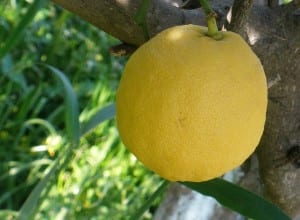I guess it is the onset of summer days that has me seeing lemon-wheel slices spinning around in my eyes. I look forward to the crisp smell of freshly cut grass and the icy glass of lemonade I am rewarded with after the sweaty task. I anticipate the hordes of lemonade stands being set up by the neighborhood kids trying to make a few bucks. I don’t know if it is the color of the lemon, a cheery sunshine-yellow, or the tart, juicy flavor that lends itself to being one of the top refreshing tastes of the summer; but I do know that it is a highly sought after fruit during this season both at the grocery store and here at the nursery.
(If you see one of these stands, pull over and buy a glass. It means so much to them!)
I’m always been a big fan of growing your own fruits and vegetables. My main reason is that you can’t beat the taste. In the end, you can’t beat the price and convenience either. So if you have a penchant for the tangy taste of lemons, or a child who wants to put all the other lemonade stands in the neighborhood to shame by rocking out an amazing refreshment, why not try your hand at growing your own citrus at home. When it comes to citrus in San Antonio, one of the best ways to grow the plant is in containers. Not only do they make a beautiful patio or front porch container accent, but planting your citrus in pots gives you the convenience of pulling the plant in for protection when cold weather is predicted. Citrus trees give you intense flavor and aroma with their fruit as well as an intoxicating aroma with their blossoms. If you’ve never smelled a citrus tree in bloom, my heart aches for you. It is a one of a kind scent and it leaves you begging for more. Let’s take a look at some of the things we need to get to started off on the right foot when potting up your citrus tree.
(I’m not the only one who can’t get enough of the scent of a lemon blossom!)
When choosing a pot, you will eventually need a larger size. Whiskey barrels, or 15-20 gallon containers are about the right size for a mature tree. You should start with a smaller pot knowing that you will eventually move up to the appropriate size container that will fit the mature tree. We recommend potting no larger than twice the diameter of the pot your purchased tree is in, and then increasing in the pots size as the plant grows. You’ll want to make sure whatever container you choose has great drainage, or you will need to provide some by drilling holes. Also remember that one of the reasons you are potting up your citrus is so you can move it when you need to. If you don’t want to spend the winter having back surgery, you might think of setting your pot on top of some coasters so that you can move the pot with ease; or invest in a multi-functional dolly if you have a lot of heavy pots to move around. Your spine will thank you. Now to fill up your pot. Get yourself some good-draining potting soil like Fox Farms Potting Soil, or Happy Frog-Ocean Forest Potting Soil. Add a few slow-release fertilizer tablets (Agriform) or a slow-release granular fertilizer like Osmocote to the soil, and then pot up your citrus tree. Plan to supplement feed with liquid Miracid (1 Tbl to every gallon) about twice a week to amp up your lemon production. However, feeding should stop after July to minimize tender, new growth that will be susceptible to damage from freezing weather.
(Nice big pots to accommodate the mature lemon trees.)
Place your pot in an area that gets full sun. You’ll realize if your lemon tree is not getting enough sun if you notice your plant getting really leggy. You can prune the branches back and scoot your tree over to an area with more sun shine. You will only water your citrus tree when it needs it. Let the top of the container dry out some between watering. I like the dip stick method to test the soil. I’m the dip, who sticks my finger down into the soil and if the soil sticks to my finger and feels wet, I pass on watering my citrus for a day or two. Just watch the weather, hotter temps mean soil in pots dry out faster, cooler weather means you can lighten up on the frequency of your watering.
(Overwatering is probably one of the most common problems we encounter with citrus care.)
When the colder weather rolls around again, you will need to take some precautions to ensure the health and survival of your citrus. Lemon trees are susceptible to freeze damage when temperatures get to about 30 degrees or lower. If the tree is left outside for the winter, it should be placed in an area that receives as much sun as possible, preferably on the south, southeast side of the house to protect from northern/northwest winds. Extra care should be taken to further protect your lemon tree such as, wrapping incandescent Christmas lights around the tree to plug in at night. The combo of the lights along with a blanket and then plastic will give the tree a warm “greenhouse” effect. The cover should be taken off the next day once the temperature has risen above freezing for a few hours. Many people opt to bring the whole pot into a sunny, warm area of their home or garage to wait out the winter months.
(Although you may not have a greenhouse, you can still protect your citrus in the winter months.)
What are you going to do with all those lemons your tree is banging out? Add some slices to an ice-cold pitcher of water? Stuff some crisp slices into a whole chicken and roast it to a golden brown? How about using the zest and juice in a pan with some olive oil or butter and garlic to toss with some angel hair pasta? A splash of lemon on some cedar plank salmon, a wedge to squeeze into a refreshing ginger tea, mixed into a sugar scrub to exfoliate rough patches of skin, however you decide to bring in the flavor of lemon to your summer season is bound to be great. And don’t be surprised if Chick-fil-A comes knocking on your door for your freshly-squeezed lemonade recipe!
The Happy Gardener
Lisa Mulroy








